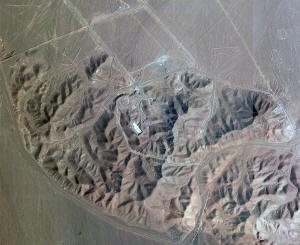Early US intelligence report suggests US strikes only set back Iran’s
nuclear program by months
[June 25, 2025]
By MICHELLE L. PRICE, MARY CLARE JALONICK, STEPHANIE
LIECHTENSTEIN and SAM McNEIL
WASHINGTON (AP) — A U.S. intelligence report suggests that Iran’s
nuclear program has been set back only a few months after U.S. strikes
and was not “completely and fully obliterated” as President Donald Trump
has said, according to two people familiar with the early assessment.
The report issued by the Defense Intelligence Agency on Monday
contradicts statements from Trump and Israeli Prime Minister Benjamin
Netanyahu about the status of Iran's nuclear facilities. According to
the people, the report found that while the Sunday strikes at the Fordo,
Natanz and Isfahan nuclear sites did significant damage, the facilities
were not totally destroyed. The people were not authorized to address
the matter publicly and spoke on condition of anonymity.
The U.S. has held out hope of restarting negotiations with Iran to
convince it to give up its nuclear program entirely, but some experts
fear that the U.S. strikes — and the potential of Iran retaining some of
its capabilities — could push Tehran toward developing a functioning
weapon.
The assessment also suggests that at least some of Iran’s highly
enriched uranium, necessary for creating a nuclear weapon, was moved out
of multiple sites before the U.S. strikes and survived, and it found
that Iran’s centrifuges, which are required to further enrich uranium to
weapons-grade levels, are largely intact, according to the people.
At the deeply buried Fordo uranium enrichment plant, where U.S. B-2
stealth bombers dropped several 30,000-pound bunker-buster bombs, the
entrance collapsed and infrastructure was damaged, but the underground
infrastructure was not destroyed, the assessment found. The people said
that intelligence officials had warned of such an outcome in previous
assessments ahead of the strike on Fordo.

The White House pushes back
The White House strongly pushed back on the DIA assessment, calling it
“flat-out wrong.”
“The leaking of this alleged assessment is a clear attempt to demean
President Trump, and discredit the brave fighter pilots who conducted a
perfectly executed mission to obliterate Iran’s nuclear program,” White
House press secretary Karoline Leavitt said in a statement. “Everyone
knows what happens when you drop fourteen 30,000 pound bombs perfectly
on their targets: total obliteration.”
The CIA and the Office of the Director of National Intelligence declined
to comment on the DIA assessment. ODNI coordinates the work of the
nation’s 18 intelligence agencies, including the DIA, which is the
intelligence arm of the Defense Department, responsible for producing
intelligence on foreign militaries and the capabilities of adversaries.
The Israeli government also has not released any official assessments of
the U.S. strikes.
Trump special envoy Steve Witkoff, who said he has read damage
assessment reports from U.S. intelligence and other nations, reiterated
Tuesday night that the strikes had deprived Iran of the ability to
develop a weapon and called it outrageous that the U.S. assessment was
shared with reporters.
“It’s treasonous so it ought to be investigated," Witkoff said on Fox
News Channel.
Trump has said in comments and posts on social media in recent days,
including Tuesday, that the strike left the sites in Iran “totally
destroyed” and that Iran will never rebuild its nuclear facilities.
Netanyahu said in a televised statement on Tuesday that, “For dozens of
years I promised you that Iran would not have nuclear weapons and indeed
... we brought to ruin Iran’s nuclear program." He said the U.S. joining
Israel was “historic" and thanked Trump.
The intelligence assessment was first reported by CNN on Tuesday.
Outside experts had suspected Iran had likely already hidden the core
components of its nuclear program as it stared down the possibility that
American bunker-buster bombs could be used on its nuclear sites.

Bulldozers and trucks visible in satellite imagery taken just days
before the strikes have fueled speculation among experts that Iran may
have transferred its half-ton stockpile of enriched uranium to an
unknown location. And the incomplete destruction of the nuclear sites
could still leave the country with the capacity to spin up weapons-grade
uranium and develop a bomb.
Iran has maintained that its nuclear program is peaceful, but it has
enriched significant quantities of uranium beyond the levels required
for any civilian use. The U.S. and others assessed prior to the U.S.
strikes that Iran’s theocratic leadership had not yet ordered the
country to pursue an operational nuclear weapon, but the head of the
International Atomic Energy Agency has repeatedly warned that Iran has
enough enriched uranium to make several nuclear bombs should it choose
to do so.
[to top of second column]
|

This satellite picture by Planet Labs PBC shows Iran's underground
nuclear enrichment site at Fordo on March 19, 2025. (Planet Labs PBC
via AP)

Vice President JD Vance said in a Monday interview on Fox News
Channel that even if Iran is still in control of its stockpile of
408.6 kilograms (900.8 pounds) of enriched uranium, which is just
short of weapons-grade, the U.S. has cut off Iran's ability to
convert it to a nuclear weapon.
“If they have 60% enriched uranium, but they don’t have the ability
to enrich it to 90%, and, further, they don’t have the ability to
convert that to a nuclear weapon, that is mission success. That is
the obliteration of their nuclear program, which is why the
president, I think, rightly is using that term,” Vance said.
Approximately 42 kilograms of 60% enriched uranium is theoretically
enough to produce one atomic bomb if enriched further to 90%,
according to the U.N. nuclear watchdog.
What experts say
Iranian Foreign Minister Abbas Araghchi informed U.N. nuclear
watchdog chief Rafael Grossi on June 13 — the day Israel launched
its military campaign against Iran — that Tehran would “adopt
special measures to protect our nuclear equipment and materials.”
American satellite imagery and analysis firm Maxar Technologies said
its satellites photographed trucks and bulldozers at the Fordo site
beginning on June 19, three days before the Americans struck.
Subsequent imagery “revealed that the tunnel entrances into the
underground complex had been sealed off with dirt prior to the U.S.
airstrikes,” said Stephen Wood, senior director at Maxar. “We
believe that some of the trucks seen on 19 June were carrying dirt
to be used as part of that operation.”
Some experts say those trucks could also have been used to move out
Iran’s enriched uranium stockpile.
“It is plausible that Iran moved the material enriched to 60% out of
Fordo and loaded it on a truck,” said Eric Brewer, a former U.S.
intelligence analyst and now deputy vice president at the Nuclear
Threat Initiative.
Iran could also have moved other equipment, including centrifuges,
he said, noting that while enriched uranium, which is stored in
fortified canisters, is relatively easy to transport, delicate
centrifuges are more challenging to move without inflicting damage.
Apart from its enriched uranium stockpile, over the past four years
Iran has produced the centrifuges key to enrichment without
oversight from the U.N. nuclear watchdog.

Iran also announced on June 12 that it has built and will activate a
third nuclear enrichment facility. IAEA chief Grossi said the
facility was located in Isfahan, a place where Iran has several
other nuclear sites. After being bombarded by both the Israelis and
the Americans, it is unclear if, or how quickly, Isfahan’s
facilities, including tunnels, could become operational.
But given all of the equipment and material likely still under
Iran’s control, this offers Tehran “a pretty solid foundation for a
reconstituted covert program and for getting a bomb,” Brewer said.
Kelsey Davenport, director for nonproliferation policy at the Arms
Control Association, a nonpartisan policy center, said that “if Iran
had already diverted its centrifuges,” it can “build a covert
enrichment facility with a small footprint and inject the 60% gas
into those centrifuges and quickly enrich to weapons grade levels.”
But Brewer also underlined that if Iran launched a covert nuclear
program, it would do so at a disadvantage, having lost to Israeli
and American strikes vital equipment and personnel that are crucial
for turning the enriched uranium into a functional nuclear weapon.
___
Liechtenstein reported from Vienna and McNeil reported from
Brussels. Associated Press writers Eric Tucker, David Klepper, Ellen
Knickmeyer and Aamer Madhani in Washington and John Leicester in
Paris contributed to this report.
All contents © copyright 2025 Associated Press. All rights reserved
 |